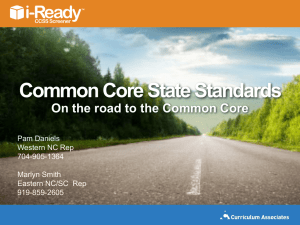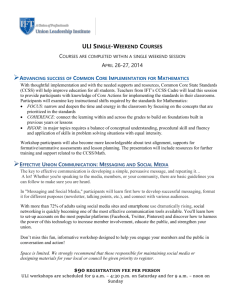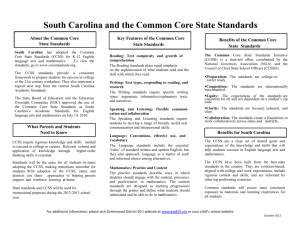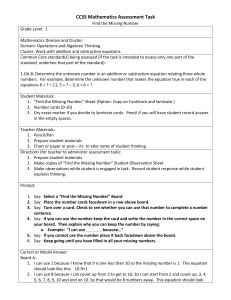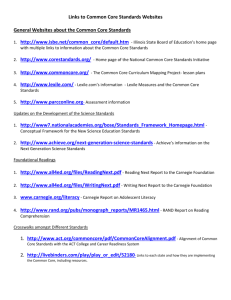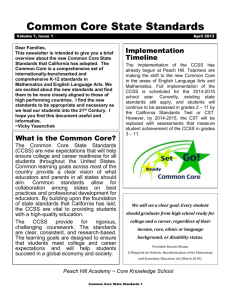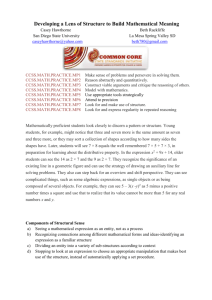Discussion
advertisement
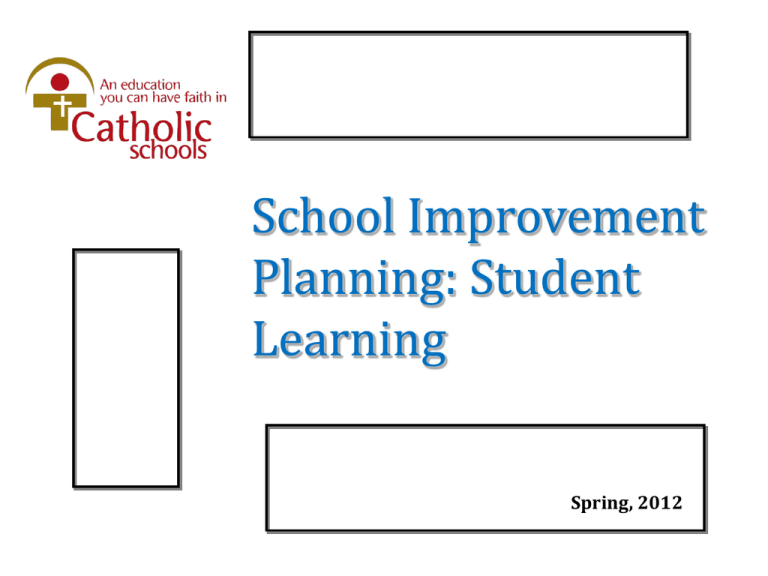
School Improvement Planning: Student Learning Spring, 2012 Let’s get started… Opposites Card Sort: Teamwork • As a team, match the opposites. One card represents best practice, the other less effective practice. Some teachers resist working with you. You go ahead and do good work. Some teachers resist working with you. You decide you can’t move ahead until everyone is compelled to work with you. Your team understands that sometimes it must “go slow to go fast” and proceeds accordingly. Your team writes an aggressive plan with expectations of large gains in student learning in one year. You help everyone in your group understand individual meeting preferences and styles, and together, analyze the capacity of the group to work together. You take charge of the group and plan meetings based on your preferences and style. Your faculty collects and analyzes data in four categories (demographic, perception, student learning, and school processes) to determine the focus of the student learning action plan. Your team reviews standardized test data and determines the focus of the student learning plan. Your team uses a consensus process to reach decisions, respecting the opinion of those who initially dissent. Your team experiences conflict among the faculty but decides to ignore it. Your team plans for quality meeting time in August to allow for full collaboration in writing/revising the school improvement plan for student learning. Your team completes the school improvement plan for student learning without input from all faculty members. You regularly review student progress, celebrate results, and make adjustments as needed. You review standardized test results once a year. You communicate your school improvement goals to parents/boards/parish community. Your school improvement goals are only shared /discussed with faculty. You explore a variety of professional learning options to assist teachers in preparing for the CCSS. Teachers are directed to implement new instructional strategies and assessments that support the CCSS. Your team, in collaboration with the faculty, maps out all professional learning for the year to support the student learning goal(s) and implementation of the CCSS. You plan the use of your in-service days for the year as you go along, not being intentional about supporting teacher and student learning. Let’s get started… • When all cards are matched, determine which card most accurately reflects your current practice as a team. Let’s get started… • Reflection questions: –How many of the cards we selected reflect best practice? –How can we move from our less effective practices to best practice? Learning from Leadership Study Effective data-use schools: • Actively use data to monitor the outcomes of School Improvement Plans • Use formative assessments at regular intervals throughout the year • Use data in making decisions about professional development planning • Use data in conversations with parents about students performance and programming • Use data to move from problem identification to problem solving What Data Do We Need to Pay Attention To? Looking Back Demographics Student Learning Perceptions School Processes Multiple Measures What Data Do We Need to Pay Attention To? Multiple Measures Worksheet: • Determine which measures you are currently using to evaluate student learning. You may have additional data sources to list. What Data Do We Need to Pay Attention To? Discussion: • Have you considered data from multiple sources? • What additional data sources could you use to inform our planning? What Data Do We Need to Pay Attention To? Looking Forward The Numbers are in… Data Review Worksheet: Growth Consistency Equity Standards Break Out Session High School Teams: Discussion and review of data sources for growth, consistency, equity, and standards. Break Out Session Elementary School Teams: Discussion and review of ECRA data. Action Plan Feedback Discussions Snapshot: Retention Data # of Students Tested Number and % of Gr. 5 Class of 2014 students since Gr. 3 Number and % of Gr. 7 Class of 2012 students since Gr. 3 Grade 3 Grade 5 Grade 7 2,495 2,485 2,465 2,138 = 86% 1,825 = 74% Snapshot: Student Achievement Cohorts READING TOTAL Number of Above Average Students (75-99) Number of Average Students (25-74) Number of Below Average Students (1-24) Spring Testing Grade 3 (2012) Results Spring Testing Grade 5 (2012) Results Spring Testing Grade 7 (2012) Results 905 886 989 1,193 1,234 1,171 397 365 305 Growth – Matched Students Spring Testing Grade 3 (2008) Results Spring Testing Grade 5 (2010) Results Spring Testing Grade 7 (2012) Results Number of Above Average Students (75-99) 764 798 835 Number of Average Students (25-74) 898 862 847 Number of Below Average Students (1-24) 165 166 143 READING TOTAL Consistency Reading Total Grade 3 Grade 5 Grade 7 2008 2,618 66 59 2,681 68 60 2,737 66 59 2009 2,681 64 58 2,694 65 58 2,650 64 58 2010 2,558 63 57 2,580 66 58 2,468 66 59 2011 2,550 62 57 2,638 65 58 2,550 66 59 2012 2,495 62 57 2,485 63 57 2,465 66 58 NP NC E NP NC E NP NC E Break Out Session Discussion and review of ECRA data. Data Review Worksheet Break Out Session Action Plan Feedback Discussions Lunch! Common Core State Standards Implications for Instruction and Assessment • The Common Core Standards emphasize student outcomes at higher levels of cognitive performance/critical thinking. • Instruction must expect higher levels of critical understanding. English Language Arts/Literacy • Building knowledge through content-rich nonfiction and informational texts • Reading and writing grounded in evidence from text • Regular practice with complex text and its academic vocabulary ELA Percentage of Informational and Non-fiction Text ELA Percentage of Writing Type Grade To Persuade To Explain To Convey Experience 4 30% 35% 35% 8 35% 35% 30% 12 40% 40% 20% Text Complexity We must systematically expose students to increasingly complex texts. TEXT COMPLEXIT Y GRADE BANDS AND ASSOCIATED LEXILE RANGES Text Complexity Grade Band in the Standards Old Lexile Ranges Lexile Ranges Aligned to CCR expectations K-1 N/A N/A 2-3 450-725 450-790 4-5 645-845 770-980 6-8 860-1010 955-1155 9-10 960-1115 1080-1305 11-CCR 1070-1220 1215-1355 Mathematics • Less content but at a much deeper level of understanding and application • Coherent progression from grade to grade. • Focus on conceptual understanding, procedural skill and fluency, and application with equal intensity. Standards for Mathematical Practice 1. Make sense of problems and persevere in solving them. 2. Reason abstractly and quantitatively. 3. Construct viable arguments and critique the reasoning of others. 4. Model with mathematics. 5. Use appropriate tools strategically. 6. Attend to precision. 7. Look for and make use of structure. 8. Look for and express regularity in repeated reasoning. Mathematics Common Core State Standard Clusters by Grade K 1 2 3 4 5 6 7 8 High School Counting and Cardinality Ratios and Proportional Reasoning Number Operations in Base Ten Number and Operations Fractions Number and Quantity The Number System Algebra Expressions and Equations Operations and Algebraic Thinking Functions Functions Geometry Measurement and Data Statistics and Probability Statistics and Probability Modeling K – 12 Domains Domains Counting and Cardinality Operations and Algebraic Thinking Number and Operations in Base Ten Measurement and Data Geometry Number and Operations - Fractions Ratios and Proportional Relationships The Number System Expressions and Equations Statistics and Probability Functions Algebra Number and Quantity Modeling K 1 2 3 4 5 6 7 8 9-12 15 MinuteBreak Problem Solving vs. Problem Identification Problem Identification: We have concerns about the CCSS and don’t feel our teachers are ready to implement them. The CCSS are coming, whether we’re ready or not. Problem Solving vs. Problem Identification Problem Identification: We have concerns about the CCSS and don’t feel our students can handle the content demands. There are no CCSS for those who need extra help. Problem Solving vs. Problem Identification Problem Identification: Our students continue to struggle in goal areas. Who? Why? Problem Solving vs. Problem Identification Problem Identification: We lack the resources to support teacher and student learning initiatives. It’s all about collaboration. Planning Professional Learning Reflection: 2011-12 Did our in-service time support our student learning plan? Did we make the best use of our professional development resources? Did we manage our time to provide frequent and job-embedded professional learning? Planning Professional Learning Office for School Professional Development Timeline CCSS Mathematics Professional Development Timeline 2012-13 Professional Learning Plan • Using the 2012-13 Professional Learning Plan worksheet, begin drafting your plan. – List the dates of your 10 calendared PD days – What days are already planned? (For example, Sustaining the Mission dates) – Add any dates from the Office for Schools PD timelines that apply Next Steps School Improvement Planning Document • Revised to allow for an Annual Review • Document that will be used for all School Improvement Goals related to accreditation Next Steps • Plan a day in August to collaboratively write/revise your student learning action plan. The day should be facilitated by the team. • Submit the plan electronically to Sue Nelson by September 30, 2012 Feedback appreciated.. • Please complete the evaluation - one per school – and leave it on the table as you leave. Thank you!
